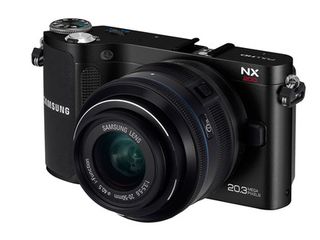2011: the year in cameras
Our review of the year in photography tech
Growing in popularity ever since the first CSC was launched in 2008, this year in many ways has been the year of the mirrorless camera, with 13 models making their entrance. We've seen Panasonic, Olympus, Samsung, Sony and newcomers Nikon bring their offerings to the table, here's what they had to show us.
Panasonic CSCs

It's been a good year for Panasonic, which announced three CSCs this year. First up, the G3, which combines the compact camera styling of the GF line with more advanced handling and control. The Micro Four Thirds camera also features an in-built electronic viewfinder.
Then, just a month later, in June, the GF3 was revealed. The company's smallest and lightest compact system camera, it features a 12.1 million pixel sensor with a maximum ISO of 6400.
Finally, the camera that many people (us included), had been waiting for, the GX1 is Panasonic's "professional" compact system camera. Featuring full-HD video recording, a robust all-metal body, a three inch touchscreen and a 16 million pixel Live MOS sensor, the camera has been designed to fill the void left by the GF1.
Read our Panasonic Lumix G3 review, or our Panasonic Lumix GF3 review, or our Panasonix GX1 review.
Sony CSCs

Another manufacturer rolling out the big guns this year, is Sony, which also announced three new compact system cameras this year. First of all, the NEX-C3 is a beginner friendly CSC featuring an APS-C 16 million pixel sensor, it also packs a tilting LCD screen and 720p video recording.
Released together, the NEX-7 and NEX-5N were announced back in August. The NEX-7 sits at the top of the line-up and features an electronic viewfinder, and an impressive 24.3 million pixel backlit APS-C sized sensor.
Get daily insight, inspiration and deals in your inbox
Get the hottest deals available in your inbox plus news, reviews, opinion, analysis and more from the TechRadar team.
The 5N, its little brother, features a 16.1 million pixel sensor, the same APS-C format sensor as other NEX cameras and a maximum ISO of 26,500.
Read our Sony NEX-7 review, our Sony NEX-5N review, or our Sony NEX-C3 review.
Pentax CSCs

Winning the award for potentially the oddest camera of the year, Pentax unveiled the Q back in June. The world's smallest interchangeable lens camera, the Pentax Q uses a 1/2.3 inch 12 million pixel rear-illuminated CMOS sensor, similar to that found in many compact cameras.
Read our Pentax Q review
Olympus CSCs

Troubled manufacturer Olympus unveiled a trio of its PEN cameras at the end of June. The E-P3 is its new flagship model, with a Micro Four Thirds 12.3 million pixel sensor, which is shared between all three new cameras in the range. The more expensive E-P3 gets you a touchscreen and extra filters, while the E-PL3 (PEN Lite), the mid-range camera features a tilt out screen. The baby of the family, the E-PM1 or PEN Mini is targeted at beginners with novice friendly on-screen guides.
Read either our Olympus PEN E-P3 review, our Olympus PEN E-PL3 review or our Olympus E-PM1 review.
Samsung CSCs

Like Sony, Samsung CSCs feature an APS-C sized sensor. The NX200 is the company's latest foray into the compact system camera arena, replacing the NX100 which was discontinued this year. The NX200's features include Full HD video recording, 7fps shooting and ISO expandable up to 12,800.
Read our Samsung NX200 review.
Nikon CSCs

Speculation had been building for months that Nikon would introduce a mirrorless camera this year. Finally in September we got to see what they had been working on in the form of the Nikon 1 system. Comprising of two different cameras, the Nikon 1 V1 is the higher specced of the two, featuring an integrated electronic viewfinder, but without an inbuilt flash. The Nikon 1 J1 on the other hand requires use of the rear LCD only, but does have a flash. Both use the same CX format 10 million pixel sensor and EXPEED 2 processor.
Read our Nikon 1 V1 review or read our Nikon 1 J1 review.
Current page: 2011 in cameras: Compact system cameras
Prev Page The Year in Cameras: DSLRs/DSLTs Next Page 2011 in cameras: compact camerasAmy has been writing about cameras, photography and associated tech since 2009. Amy was once part of the photography testing team for Future Publishing working across TechRadar, Digital Camera, PhotoPlus, N Photo and Photography Week. For her photography, she has won awards and has been exhibited. She often partakes in unusual projects - including one intense year where she used a different camera every single day. Amy is currently the Features Editor at Amateur Photographer magazine, and in her increasingly little spare time works across a number of high-profile publications including Wired, Stuff, Digital Camera World, Expert Reviews, and just a little off-tangent, PetsRadar.

